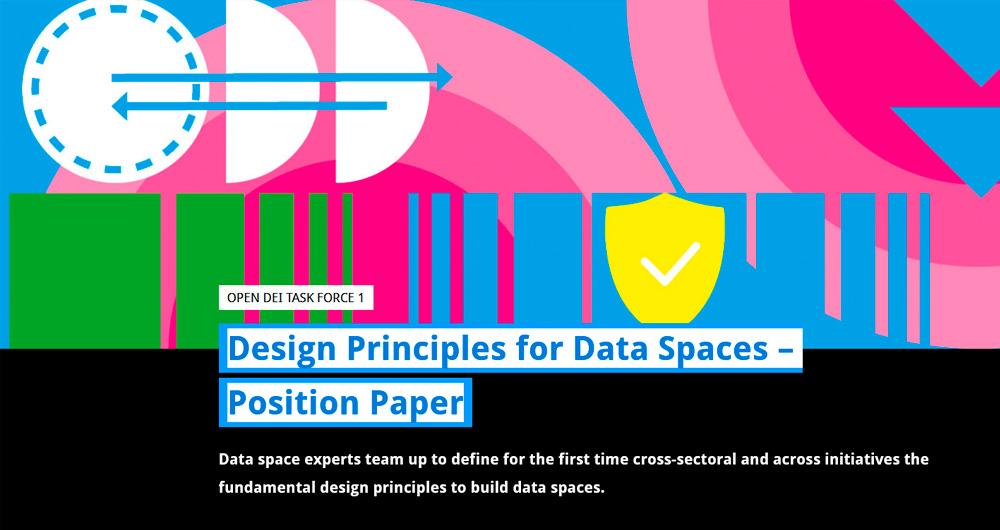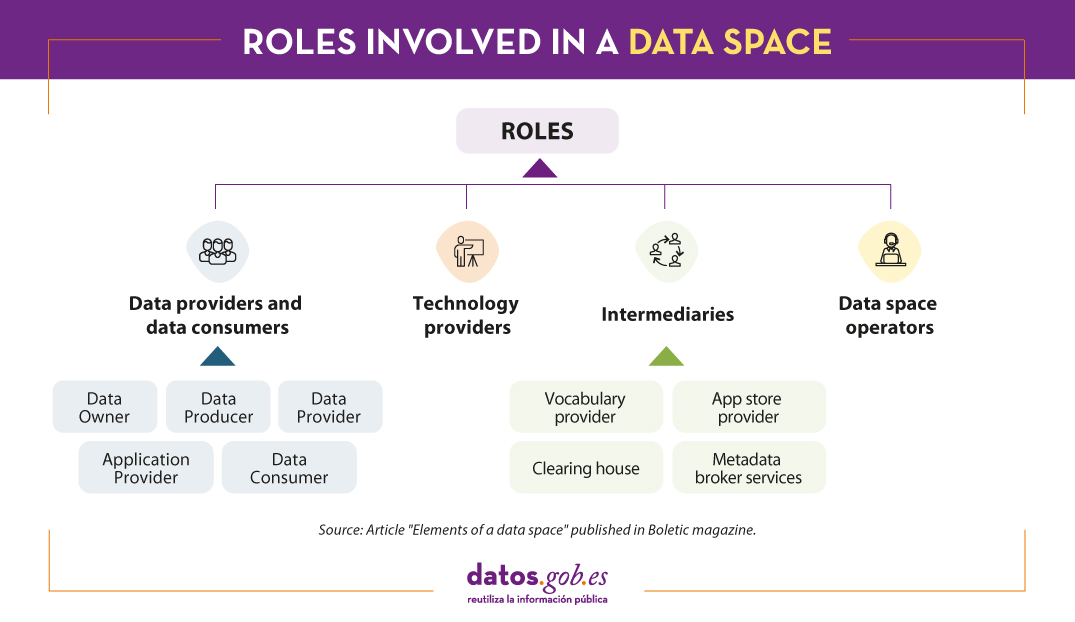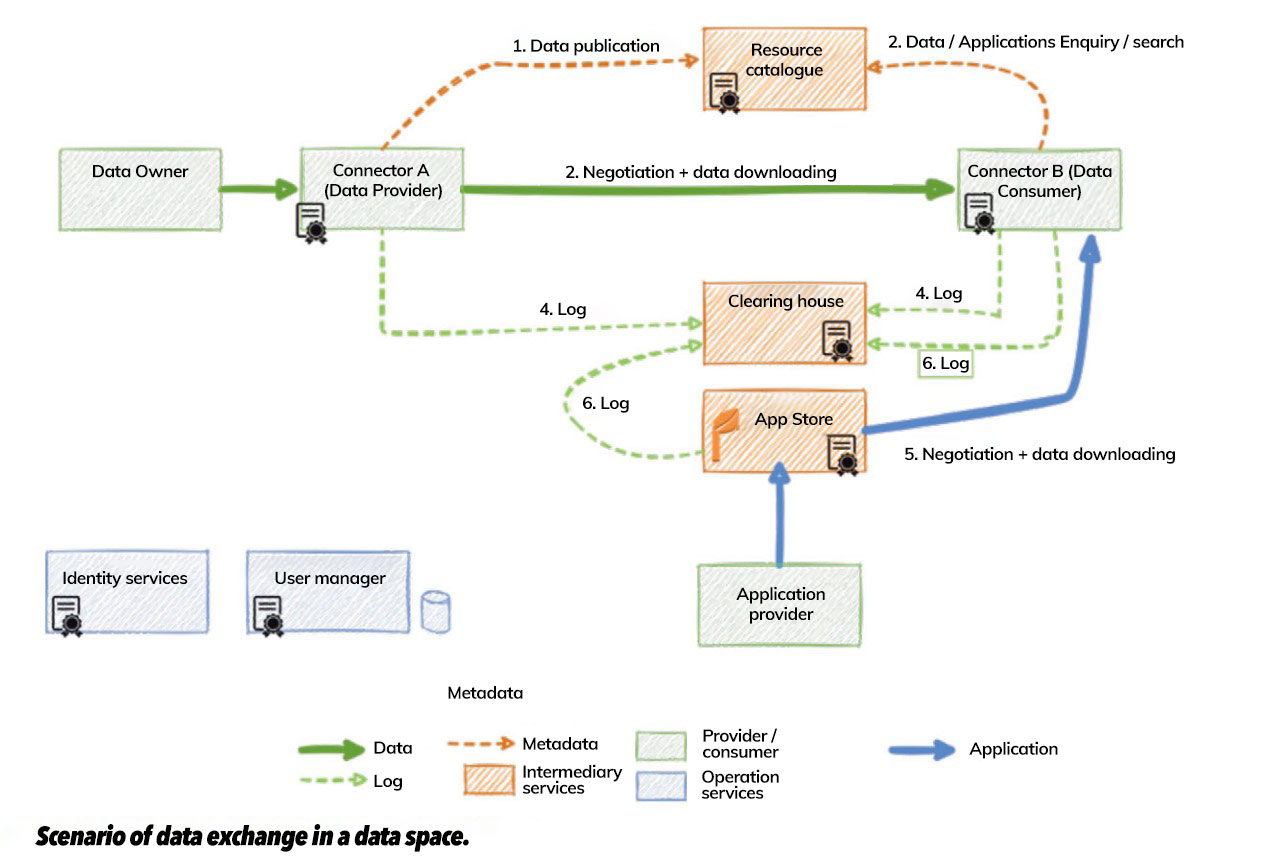
For a data space to function properly, it is necessary to have sufficient actors to cover a set of roles and a set of technological components. These elements enable a common governance framework to be established for secure data sharing, ensuring the sovereignty of the participants over their own data. This concept, data sovereignty, can be defined as the ability of the data owner to set the policies for the use and access of the data to be exchanged, and is the core element of a data space.
In this sense, the EU-funded report "Design Principles for Data Spaces" (April 2021) provides the fundamentals that data spaces should follow in order to act in accordance with EU values: decentralisation, openness, transparency, sovereignty and interoperability. The report was prepared by experts from 25 different companies, thus giving a consensus view with industry.
The following is a summary of some of the main contributions of the document, taking as a reference the article "Elements of a data space" published in the Boletic magazine of the Professional Association of Information Systems and Technologies. In this article, the elements of a data space are divided into two categories:
- Roles and domains
- Fundamental components
Roles
In a data space we can find different participants, each of them focused on a specific field of action. This is known as roles:

-
Data providers and data consumers
These are the participants who provide and interact with the data. Within this category there are several roles:
- Data Producer: Generates the data.
- Data Owner: The holder of the rights to access and use the data.
- Data Acquirer or Data Provider: Captures the data and offers it through the data space catalogue.
- Data Consumer: Accesses the data from the catalogue.
- Application Provider: Provides applications that allow working with the data offering added value (e.g. machine learning models, visualisations, cleansing processes, etc.).Intermediaries
-
Intermediaries
In this case we are talking about third parties that offer the services necessary for publishing, searching for resources and registering transactions. Some examples of services offered by intermediaries are:
- Vocabularies and ontologies, which allow information to be systematically organised, categorised or labelled, improving interoperability.
- Application stores, which list the tools offered by application providers, ensuring that they have passed a quality control process.
- Metadata broker services for the publication of a catalogue of resource offerings (data and applications) with as much information as possible.
- Orchestration services, allowing the automation of various activities.
- Clearing house, which allow to keep control of the operations carried out.
-
Technology providers
They provide components for the data space to operate correctly, making it a secure and trusted environment. Examples of these components are the connector - a fundamental element that we will see below -, user management systems or monitoring systems.
Brokerage services and applications do not fall into this category.
-
Data space operators
Focused on the management of the space, they carry out tasks such as the processing of requests or incidents, change control, software maintenance, etc. Among other things, they certify participants, exercise the governance of the data space and define the roadmap of functionalities.
All these roles are not exclusive, and the same user can adopt several roles.
Components of a data space
There are different approaches to the components that a data space should have. One can refer to Gaia-X and/or take as a reference the IDS-RAM architecture model (Reference Architecture model), characterised by an open, reliable and federated architecture for cross-sector data exchange.
In any case, at least the following blocks are necessary for carrying out the activity in a secure and controlled manner:
-
Components for accessing the data space: Connector
One of the main elements of data spaces is the connector, through which participants access the data space and the data. It is responsible for handling the data according to the usage policies defined by the owner of the access and usage rights, guaranteeing its sovereignty. To prevent malicious manipulation, connectors can be signed by a certificate provided by the data space governance, so as to guarantee their integrity and compliance with the usage rights established by the data owner.
-
Components for intermediation
They allow for the intermediation services mentioned above, the metadata broker, the app store, etc. Of all of them, the most fundamental is the resource catalogue. In addition to a list of the available offer, it is also the tool that allows the resource provider, its characteristics and conditions of use to be located.
-
Components for identity management and secure data exchange
These components ensure the identity of participants and the security of transactions. For this reason, participants are often required to present credentials (e.g. via X.509 certificates).
-
Data space management components
These are tools that allow the data space to operate normally, facilitating daily operations, management of participants (registration, deregistration, revocation, suspension), monitoring of the activity, etc.
How do all these elements interact?
All these roles and components interact with each other. First, the data provider registers its data offering in the catalogue, including relevant metadata such as usage policies. The data consumer searches the catalogue for datasets and applications of interest. Once located, he/she contacts the provider, communicating which resources he wants to acquire. In this process, further negotiation of terms and conditions may take place. Once an agreement is reached, the consumer can download the data.
The transaction must be registered by both the supplier and the consumer.

All these elements (roles, components and processes) allow data sharing in a secure and controlled manner, in a managed environment of trust. The aim is to enable European companies and organisations to exchange information, generating a European data market that will give rise to new products and services of value, boosting the European economy.
Content prepared by the datos.gob.es team.